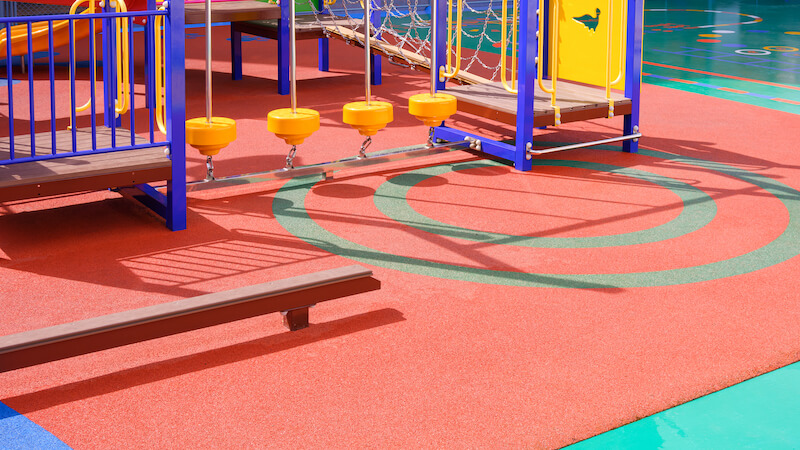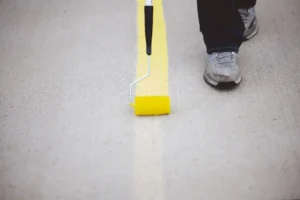Playgrounds serve as more than just spaces for children to burn off excess energy; they are dynamic environments where creativity and imagination flourish. Amidst the swings and slides, one often overlooked yet crucial element stands out – playground lines. Playgrounds are not merely spaces for physical activity; they are vibrant canvases for the blossoming creativity and boundless imagination of children. Among the various elements that contribute to the magic of play, playground lines stand out as unassuming yet essential components.
Section 1: The Canvas of Imagination
Picture a vibrant playground scene, and invariably, the vivid patterns of lines etched onto the ground come to mind. These lines are not mere boundaries; they are the canvas upon which children paint the tapestry of their imaginative worlds. Hopscotch grids, four-square courts, and winding mazes—each line delineates a space that invites exploration and sparks creativity.
Section 2: Beyond Boundaries
Paradoxically, while playground lines establish physical boundaries, they also encourage children to think beyond limits. Within the constraints of hopscotch or the boundaries of foursquare, children find the inspiration to invent new rules, create alternate universes, and extend their play beyond the predefined spaces. The lines, initially confining, become launching pads for a flight of imagination that knows no bounds.

Section 3: Social Interaction and Collaboration
The allure of playground lines goes beyond individual play; it extends to fostering social interaction and collaboration among children. Whether forming teams for a game of tag, negotiating rules for an impromptu sport, or delineating territories for make-believe adventures, the lines serve as the foundation for shared experiences. Children learn the art of sharing, effective communication, and the importance of working together—all within the framework of these playful boundaries.
Section 4: Spatial Awareness and Motor Skills
Engaging with playground lines is not solely about imaginative play; it is a holistic physical and cognitive exercise. Jumping from one line to another, navigating intricate mazes, or carefully balancing on designated paths—all contribute to the development of spatial awareness and motor skills. The seemingly simple act of following or crossing lines becomes a crucial component of a child’s physical and mental development.
Section 5: Educational Opportunities
What appears to be pure play is often a cleverly disguised educational experience. Playground lines offer rich opportunities for learning, from counting steps in hopscotch to identifying shapes in line-based games. Children effortlessly absorb mathematical concepts, spatial relationships, and even basic physics in the midst of their playful escapades, setting a strong foundation for future academic pursuits.
Section 6: Freedom in Structure
One might assume that the structured nature of playground lines stifles creativity, but quite the opposite is true. The beauty lies in the balance between structure and freedom. The lines provide a framework for play, a starting point for creativity, while still allowing children the freedom to interpret, adapt, and extend these spaces according to their unique imaginations. This delicate balance fosters a sense of autonomy and self-expression.

Section 7: Cultivating Problem-Solving Skills
As children engage with playground lines, they encounter challenges and obstacles that require problem-solving. Whether strategizing to win a game, negotiating playtime rules, or resolving conflicts during play, these experiences contribute significantly to the development of crucial problem-solving skills. The playground becomes a training ground for navigating real-life challenges with creativity and resilience.
Section 8: Cultural and Creative Expression
Playground lines are not confined to generic patterns; they often feature cultural and creative expressions. Whether designed as vibrant mosaics or incorporating symbols from different cultures, these markings contribute to a rich and diverse play environment. Children are exposed to various forms of artistic expression, fostering an early appreciation for cultural diversity and creativity.
Section 9: Encouraging Physical Activity
In an era dominated by digital screens, encouraging physical activity among children is more critical than ever. Playground lines play a pivotal role in seamlessly blending physical movement with imaginative play. Whether running along lines, jumping from one to another, or engaging in organized games, children develop a love for movement and exercise in the context of imaginative play.
Section 10: Future Innovations in Playgrounds
As we look ahead, playgrounds are evolving to incorporate technology and interactive elements. From augmented reality games projected onto surfaces to smart playground lines that respond to touch, the future of playground design holds exciting possibilities. These innovations aim to enhance the immersive and imaginative experience, ensuring that playgrounds remain dynamic and captivating spaces for generations to come.
Conclusion:
Playground lines transcend their role as mere ground markings; they are integral to the very essence of childhood play. They stimulate creativity, nurture imagination, and contribute to holistic childhood development. As children engage with these lines, they embark on journeys of self-discovery, social interaction, and learning. The design and thoughtful integration of playground lines play a pivotal role in shaping the playground into a space where imagination knows no bounds, ensuring that every child’s playtime is an adventure filled with limitless possibilities.




